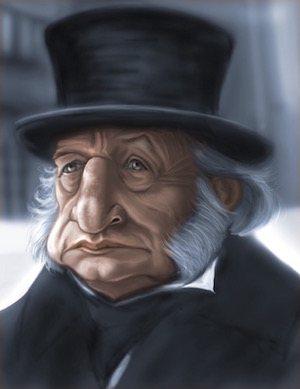Scrooge: the main character of Charles Dickens’ 1843 novella, A Christmas Carol. In everyday language, a “Scrooge” is a miserly person who does not like to pay for anything, although they generally have ample resources to do so.
_______________
Once upon a time, not such a long time ago, there was a certain order in the intellectual property world where large companies were readily licensing rights and technology to one another and were holding themselves to a certain “honor system” (to quote former Federal Court of Appeals Justice Michel) when it came to respecting the IP of others. Occasionally, a small inventor would knock at their door to offer them a license on their patent. If they saw value in integrating the invention or it was apparent that they were already practicing it, they would normally oblige and pay a fair reward to the inventor. This pattern then provided fuel for more innovation.
A decade or so ago, some decisions from the higher courts and a few large awards that ensued and made the headlines served to further tip the balance in favor of patent owners, and patents suddenly became a hot commodity. This led in turn to a few jaw-dropping mega deals (e.g. the Nortel portfolio, which sold for $5.4B) that more or less established patents as a distinct asset class, at least in the US, where most of this was happening.
With that phenomenon, we entered into what I’d call the intermediation of IP featuring newly formed entities that did not necessarily practice the patents they owned, let alone invent them. These entities acquired such patents en masse. They did so either with the intent of aggregating them in large enough numbers so as to become a “one stop” IP licensing shop (the Intellectual Ventures model), or acted as a proxy to the inventors by simply requesting alleged infringers to take a license thereon. They then asserted the patents in court when their demands were declined (the Acacia model).
Today, Intellectual Ventures, long the IP marketplace bellwether, is only a shadow of its past self as it tries to unload scores of the 40,000 + patents it acquired at the highest point of the market. Their latest fund is being managed out of Ireland, they have reduced their staff by over a third overall and their acquisition team is now pared down to a skeleton crew. Acacia Research (which is publicly traded), dropped over the last 3 years from a market capitalization of $2B to one of a mere $200M, a 90% dive! Last Friday, it lost an important case on their marquee Adaptix portfolio (which they had paid $160M for in 2012) and we just learned that their CEO resigned earlier this week! Most other NPEs are faring as bad, have closed their doors or have changed business models.
What happened? In short, the US Supreme Court has for all intents and purposes removed the specter of an injunctive relief against patent infringers in the Ebay decision, and other more recent decisions have made it increasingly harder for patent owners to enforce their rights. Nor surprisingly, nobody wants to take a license anymore. Indeed, why pay for rights that the court system and the USPTO itself have made so uncertain?
Meet the new “patent Scrooges”, whom people also like to call “efficient infringers”.
According to Robert Taylor, a patent lawyer who represents the National Venture Capital Association and was quoted in a recent New York Times article written by columnist Joe Nocera entitled The Patent Troll Smokescreen, “Efficient Infringing” a term recently coined in Silicon Valley, describes a “new practice of using a technology that infringes on someone’s patent, while ignoring the patent holder entirely. And when the patent holder discovers the infringement and seeks recompense, the infringer responds by challenging the patent’s validity. Should a lawsuit ensue, the infringer, often a big tech company, has top-notch patent lawyers at the ready. Because the courts have largely robbed small inventors of their ability to seek an injunction — that is, an order requiring that the infringing product be removed from the market — the worst that can happen is that the infringer will have to pay some money. For a rich company like, say, Apple, that is no big deal.”
Indeed, an article of the influential Wall Street Journal published just a few weeks ago exhorted the value of ignoring patent demand letters altogether as a corporate strategy, a position immediately deplored by well-respected PatentlyO editor and law professor Dennis Crouch.
So it now looks like this: if you are a patent owner and feel that your rights have been encroached upon, you now have to assume there will be a challenge to their validity by a potential licensee through an Inter Partes Review (IPR). If you are one of the lucky few (~25%) who survive such a challenge with at least one valid patent claim, you then have to expect an appeal. Assuming you win that appeal, then the real court battle starts in earnest and you’ll have to face what has now become a $3-5M ordeal in legal fees to get through a full trial on the merits and the routinely filed appeal should you beat all odds and win. Treble damages for willful infringement have been rarer than a dodo bird sighting and even winning does not mean you will collect your money any time soon, as the Apple-Samsung saga has recently shown.
This means that any incentive a large entity with deep pockets has had to pay patent owners to keep the privilege of practicing their invention is essentially gone. Those companies have made the calculation -and no one can really blame them for doing so- that it is a lot cheaper to defer payment to patent owners for years, with no real downside if they ultimately lose, and with the added bonus that most patent owners will throw in the towel long before that as they run out of money.
Two important and much awaited court decisions could change that. First, the Federal Court of Appeals may soon be ruling en banc on the request by Apple (initially denied by the district court then reversed by a 3 judge panel) to have a permanent injunction forcing Samsung to change the design of its picture app icon which was held to infringe Apple’s design patent. This would be a major reversal of Ebay and its progeny and would send a shock wave to operating companies who have jumped on the “efficient infringing” bandwagon.
Second, in accepting to hear the combined cases of Halo and Stryker, the US Supreme Court is set to rule in the next months on the test for awarding “enhanced damages” in patent cases, and many expect the highest tribunal to lower the standard that has made it almost impossible for successful plaintiffs to collect treble damages from willful infringers. Either one of these two decisions would significantly change the current environment; a pro patentee ruling on both would profoundly impact the landscape and bring the IP marketplace in a much better state of equilibrium where legitimate patent owners can be rewarded, while those who want to abuse the system are penalized accordingly.

![[IPWatchdog Logo]](https://ipwatchdog.com/wp-content/themes/IPWatchdog%20-%202023/assets/images/temp/logo-small@2x.png)


![[Advertisement]](https://ipwatchdog.com/wp-content/uploads/2024/04/Patent-Litigation-Masters-2024-sidebar-early-bird-ends-Apr-21-last-chance-700x500-1.jpg)

![[Advertisement]](https://ipwatchdog.com/wp-content/uploads/2021/12/WEBINAR-336-x-280-px.png)
![[Advertisement]](https://ipwatchdog.com/wp-content/uploads/2021/12/2021-Patent-Practice-on-Demand-recorded-Feb-2021-336-x-280.jpg)
![[Advertisement]](https://ipwatchdog.com/wp-content/uploads/2021/12/Ad-4-The-Invent-Patent-System™.png)







Join the Discussion
9 comments so far.
Guy Fielder
January 7, 2016 11:21 pmI am an inventor and not licensed to practice law. The fluid landscape makes it difficult for the plaintiff side of the table and the uncertainty gives the infringing party all the trump cards. A Google or a Microsoft can wait decades for the courts to offer a verdict still vague and in-determinant; meanwhile the meter is running on the life of the patent and the expenses of litigation. Add in billions to purchase Congress and the only way this can end well for the small inventor would be if Congress magically discovered integrity and ethics.
Titus
January 4, 2016 02:39 pmBig thanks for this great piece. We hold a patent on a tool system, and have refrained from submitting to larger manufactures, specifically because of infringement/re-engineering concerns. We will be watching both cases closely.
Again, thanks for shedding light on this.
Mike Lloyd
January 3, 2016 04:55 pmGreat article, but I have a question. The author claims that only 25% of patents survive an IPR with at least one valid patent claim
Meanwhile the USPTO claims that only 25% of challenged claims in an IPR are found to be unpatentable:
http://www.uspto.gov/blog/director/entry/ptab_update_proposed_changes_to
Can you please explain this difference in data? Do you have a source for the first figure?
Gunrunner
January 2, 2016 03:14 pmMight be time to look back. At an earlier time a company would have their enforcers pay a visit to the infringing company. In no better terms the infringer would soon try to enter into an agreement with the patent holder or just plain stop using the in question property and intellectual property of the patentee.
These things have a way of sorting themselves out in the old style of business contact.
Sounds like a good time to relive the good old days!
Dan
December 31, 2015 09:58 amRejuvenating enhanced damages is much needed for patentees. Plus, the Federal Circuit has approved asking juries whether, after calculating a reasonable royalty, an additional sum is warranted to “adequately compensate” the patentee for the use made by the infringer as the patent act demands. When the combination of a reasonable royalty and any additional sum are subject to enhancement, under a less stringent standard, that calculus should finally turn some heads.
Charles Mauro
December 31, 2015 09:14 amLouis: Great piece, but you overlooked the possible CERT in Apple v. Samsung related essentially to design patents and the attack on 289. If the SC takes up the CERT and rules against 286 the entire landscape of design patents will be altered and not for the good.
Benny
December 31, 2015 05:35 amNight,
You are already well in the dark, as you put it. I don’t believe any manufacturer programs an “embedded computing” device without putting read-protection in place. Even if they do file patent applications, you have no way of knowing if the actual device on the market isn’t running a more advanced version than that disclosed to the public. I’m not at all sure that the alternative you propose would be a better option for manufacturers or the consumers.
Paul Morinville
December 31, 2015 01:15 amNight Writer, Judging by the drop in patent applications and maintenance fees, perhaps we have already gone dark.
Night Writer
December 30, 2015 10:51 pmI’ve had conversations with top notch inventors who basically want a way to hide what they did and not file a patent application. As soon as the big internationals get their trade secret laws into place, then the companies can hire people to build the systems they invented and force them to keep quiet about it. We are going to go dark soon for any invention that can be hiden behind a firewall.